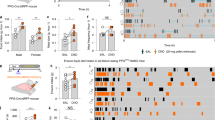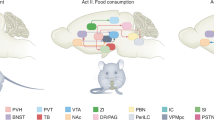Abstract
Obesity constitutes a major global healthcare challenge. The morbidity, mortality, and socioeconomic costs of obesity are considerable. No currently available medical therapy delivers substantial, sustainable weight loss. The need to better understand the mechanisms of appetite regulation is therefore clear. Over the last 20 years, peptide hormones released from the gastrointestinal tract in response to nutritional stimuli have come to be recognized as important physiological regulators of appetite. Hormones such as peptide YY, pancreatic polypeptide, glucagon-like peptide-1 and oxyntomodulin are thought to act as postprandial satiety signals. These physiological pathways of appetite control offer a promising basis for anti-obesity therapies. Here, we briefly review the state of current knowledge of these hormones' actions on brain appetite circuits, and prospects for future research and development.
This is a preview of subscription content, access via your institution
Access options
Subscribe to this journal
Receive 12 print issues and online access
$259.00 per year
only $21.58 per issue
Buy this article
- Purchase on Springer Link
- Instant access to full article PDF
Prices may be subject to local taxes which are calculated during checkout
Similar content being viewed by others
References
World Health Organization. Global Strategy on Diet, Physical Activity and Health. World Health Organization: Geneva, Switzerland, 2004.
Allison DB, Saunders SE . Obesity in North America. An overview. Med Clin North Am 2000; 84: 305–332.
Kaplan LM . Pharmacological therapies for obesity. Gastroenterol Clin North Am 2005; 34: 91–104.
Thearle M, Aronne LJ . Obesity and pharmacologic therapy. Endocrinol Metab Clin North Am 2003; 32: 1005–1024.
Stanley S, Wynne K, McGowan B, Bloom S . Hormonal regulation of food intake. Physiol Rev 2005; 85: 1131–1158.
Schwartz GJ . Integrative capacity of the caudal brainstem in the control of food intake. Philos Trans R Soc Lond B Biol Sci 2006; 361: 1275–1280.
Ellacott KL, Cone RD . The role of the central melanocortin system in the regulation of food intake and energy homeostasis: lessons from mouse models. Philos Trans R Soc Lond B Biol Sci 2006; 361: 1265–1274.
Koda S, Date Y, Murakami N, Shimbara T, Hanada T, Toshinai K et al. The role of the vagal nerve in peripheral PYY3-36-induced feeding reduction in rats. Endocrinology 2005; 146: 2369–2375.
Abbott CR, Monteiro M, Small CJ, Sajedi A, Smith KL, Parkinson JR et al. The inhibitory effects of peripheral administration of peptide YY(3–36) and glucagon-like peptide-1 on food intake are attenuated by ablation of the vagal-brainstem-hypothalamic pathway. Brain Res 2005; 1044: 127–131.
Le Roux CW, Neary NM, Halsey TJ, Small CJ, Martinez-Isla AM, Ghatei MA et al. Ghrelin does not stimulate food intake in patients with surgical procedures involving vagotomy. J Clin Endocrinol Metab 2005; 90: 4521–4524.
Gibbs J, Young RC, Smith GP . Cholecystokinin decreases food intake in rats. J Comp Physiol Psychol 1973; 84: 488–495.
Badman MK, Flier JS . The gut and energy balance: visceral allies in the obesity wars. Science 2005; 307: 1909–1914.
Chaudhri O, Small C, Bloom S . Gastrointestinal hormones regulating appetite. Philos Trans R Soc Lond B Biol Sci 2006; 361: 1187–1209.
Korner J, Bessler M, Cirilo LJ, Conwell IM, Daud A, Restuccia NL et al. Effects of Roux-en-Y gastric bypass surgery on fasting and postprandial concentrations of plasma ghrelin, peptide YY, and insulin. J Clin Endocrinol Metab 2005; 90: 359–365.
Le Roux CW, Aylwin SJ, Batterham RL, Borg CM, Coyle F, Prasad V et al. Gut hormone profiles following bariatric surgery favor an anorectic state, facilitate weight loss, and improve metabolic parameters. Ann Surg 2006; 243: 108–114.
Turton MD, O'Shea D, Gunn I, Beak SA, Edwards CM, Meeran K et al. A role for glucagon-like peptide-1 in the central regulation of feeding. Nature 1996; 379: 69–72.
Baggio LL, Huang Q, Brown TJ, Drucker DJ . Oxyntomodulin and glucagon-like peptide-1 differentially regulate murine food intake and energy expenditure. Gastroenterology 2004; 127: 546–558.
Verdich C, Flint A, Gutzwiller JP, Naslund E, Beglinger C, Hellstrom PM et al. A meta-analysis of the effect of glucagon-like peptide-1 (7–36) amide on ad libitum energy intake in humans. J Clin Endocrinol Metab 2001; 86: 4382–4389.
Dakin CL, Small CJ, Batterham RL, Neary NM, Cohen MA, Patterson M et al. Peripheral oxyntomodulin reduces food intake and body weight gain in rats. Endocrinology 2004; 145: 2687–2695.
Cohen MA, Ellis SM, Le Roux CW, Batterham RL, Park A, Patterson M et al. Oxyntomodulin suppresses appetite and reduces food intake in humans. J Clin Endocrinol Metab 2003; 88: 4696–4701.
Wynne K, Park AJ, Small CJ, Patterson M, Ellis SM, Murphy KG et al. Subcutaneous oxyntomodulin reduces body weight in overweight and obese subjects: a double-blind, randomized, controlled trial. Diabetes 2005; 54: 2390–2395.
Wynne K, Park AJ, Small CJ, Meeran K, Ghatei MA, Frost GS et al. Oxyntomodulin increases energy expenditure in addition to decreasing energy intake in overweight and obese humans: a randomised controlled trial. Int J Obes (London) 2006; 30: 1729–1736.
Green BD, Flatt PR, Bailey CJ . Dipeptidyl peptidase IV (DPP IV) inhibitors: A newly emerging drug class for the treatment of type 2 diabetes. Diab Vasc Dis Res 2006; 3: 159–165.
Boggiano MM, Chandler PC, Oswald KD, Rodgers RJ, Blundell JE, Ishii Y et al. PYY3-36 as an anti-obesity drug target. Obes Rev 2005; 6: 307–322.
Batterham RL, Cowley MA, Small CJ, Herzog H, Cohen MA, Dakin CL et al. Gut hormone PYY(3–36) physiologically inhibits food intake. Nature 2002; 418: 650–654.
Batterham RL, Cohen MA, Ellis SM, Le Roux CW, Withers DJ, Frost GS et al. Inhibition of food intake in obese subjects by peptide YY3-36. N Engl J Med 2003; 349: 941–948.
Pittner RA, Moore CX, Bhavsar SP, Gedulin BR, Smith PA, Jodka CM et al. Effects of PYY[3–36] in rodent models of diabetes and obesity. Int J Obes Relat Metab Disord 2004; 28: 963–971.
Sileno AP, Brandt GC, Spann BM, Quay SC . Lower mean weight after 14 days intravenous administration peptide YY(3–36) (PYY(3–36)) in rabbits. Int J Obes (London) 2006; 30: 68–72.
Koegler FH, Enriori PJ, Billes SK, Takahashi DL, Martin MS, Clark RL et al. Peptide YY(3–36) inhibits morning, but not evening, food intake and decreases body weight in rhesus macaques. Diabetes 2005; 54: 3198–3204.
Degen L, Oesch S, Casanova M, Graf S, Ketterer S, Drewe J et al. Effect of peptide YY3-36 on food intake in humans. Gastroenterology 2005; 129: 1430–1436.
Brandt G, Park A, Wynne K, Sileno A, Jazrawi R, Woods A et al. Nasal peptide YY3-36: Phase 1 dose ranging and safety studies in healthy human subjects. 86th Annual Meeting of the Endocrine Society (ENDO 2004). New Orleans, LA 2004.
Lassmann V, Vague P, Vialettes B, Simon MC . Low plasma levels of pancreatic polypeptide in obesity. Diabetes 1980; 29: 428–430.
Fujimoto S, Inui A, Kiyota N, Seki W, Koide K, Takamiya S et al. Increased cholecystokinin and pancreatic polypeptide responses to a fat-rich meal in patients with restrictive but not bulimic anorexia nervosa. Biol Psychiatry 1997; 41: 1068–1070.
Jorde R, Burhol PG . Fasting and postprandial plasma pancreatic polypeptide (PP) levels in obesity. Int J Obes 1984; 8: 393–397.
Wisen O, Bjorvell H, Cantor P, Johansson C, Theodorsson E . Plasma concentrations of regulatory peptides in obesity following modified sham feeding (MSF) and a liquid test meal. Regul Pept 1992; 39: 43–54.
Asakawa A, Inui A, Ueno N, Fujimiya M, Fujino MA, Kasuga M . Mouse pancreatic polypeptide modulates food intake, while not influencing anxiety in mice. Peptides 1999; 20: 1445–1448.
Batterham RL, Le Roux CW, Cohen MA, Park AJ, Ellis SM, Patterson M et al. Pancreatic polypeptide reduces appetite and food intake in humans. J Clin Endocrinol Metab 2003; 88: 3989–3992.
Zipf WB, O'Dorisio TM, Cataland S, Dixon K . Pancreatic polypeptide responses to protein meal challenges in obese but otherwise normal children and obese children with Prader–Willi syndrome. J Clin Endocrinol Metab 1983; 57: 1074–1080.
Neary NM, Small CJ, Druce MR, Park AJ, Ellis SM, Semjonous NM et al. Peptide YY3-36 and glucagon-like peptide-17-36 inhibit food intake additively. Endocrinology 2005; 146: 5120–5127.
Ogihara T, Matsuzaki M, Matsuoka H, Shimamoto K, Shimada K, Rakugi H et al. The combination therapy of hypertension to prevent cardiovascular events (COPE) trial: rationale and design. Hypertens Res 2005; 28: 331–338.
Author information
Authors and Affiliations
Corresponding author
Additional information
Conflict of interest
Stephen R Bloom received consulting fees from Thiakis, lecture fees from Astra-Zeneca and Novartis, grant support from Medtronics, and is the named inventor for PYY and Oxyntomodulin patents and patent applications. The remaining authors have declared no financial interests.
Rights and permissions
About this article
Cite this article
Chaudhri, O., Field, B. & Bloom, S. Gastrointestinal satiety signals. Int J Obes 32 (Suppl 7), S28–S31 (2008). https://doi.org/10.1038/ijo.2008.235
Published:
Issue Date:
DOI: https://doi.org/10.1038/ijo.2008.235
Keywords
This article is cited by
-
The role of fatty acids in insulin resistance
Lipids in Health and Disease (2015)
-
The gut as a sensory organ
Nature Reviews Gastroenterology & Hepatology (2013)



